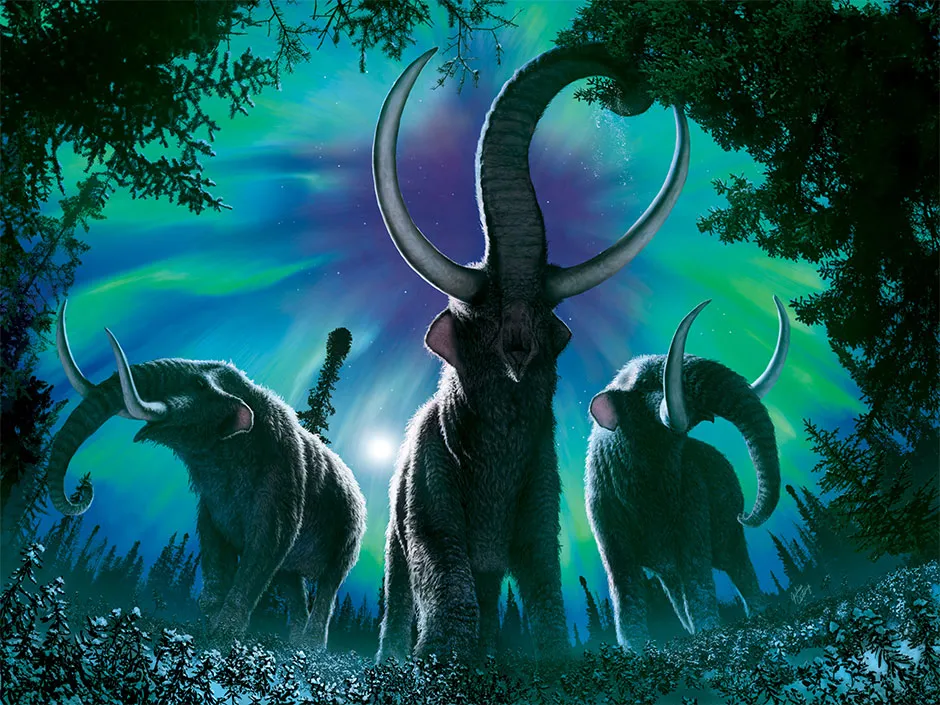Mastodons, distant relatives of the elephant, travelled large distances across North America due to climate change 2.5 million to 11,700 years ago, a new study suggests.
Researchers say dramatic environmental changes accompanying the shift or melting of continental glaciers played a key role as American mastodons moved north from their southern ranges.
The animals were among the largest living land animals on Earth at the time, roaming from Beringia (present-day Alaska and the Yukon) east to Nova Scotia and south to central Mexico.They were primarily browsers, living in swampy settings, and eating shrubs and low-hanging tree branches.
In the first large-scale genetic study of American mastodons, published in the Nature Communications journal, researchers studied fossilised samples, including the teeth, tusks and bones, of 33 individual animals.
Read more about extinction:
- Extinct woolly rhinos were a victim of climate change, not overhunting
- De-extinction: Can we bring extinct animals back from the dead?
Around 11,000 years ago the species died out during the megafaunal extinctions which took out many of the large mammals such as mammoths, sabre-toothed cats and giant ground sloths.
Evolutionary geneticist Hendrik Poinar, director of the McMaster Ancient DNA Centre and author on the study, said: “The genetic data show a strong signal of migration, moving back and forth across the continent, driven what appears to be entirely by climate.
“These mastodons were living in Alaska at a time when it was warm, as well as Mexico and parts of Central America. These weren’t stationary populations – the data show there was constant movement back and forth.”
According to the researchers, dramatic and repeated temperature fluctuations took place routinely on the planet for millions of years.Cycles of glacial and interglacial periods over the last 800,000 years resulted in periodic expansion of the ice sheet across approximately 50 per cent of the habitable land in North America.
Researchers identified five distinct groups – or clades – of mastodons.Two originated from eastern Beringia (a region that historically adjoined Russia and America).
The authors found no overlap in the ages of the specimens from the eastern Beringia groups and suggest that the two clades likely resulted from separate expansions into this region.This coincided with interglacial periods when warm climatic conditions supported the establishment of forests and wetlands, according to the study.

The research suggests that mastodons were travelling vast distances in response to warming climate conditions and melting ice sheets, from warmer environments to the northernmost reaches of Alaska and the Yukon.
However, despite these massive increases in territory, northern populations were much less genetically diverse, rendering them more vulnerable to extinction.
Emil Karpinski, lead author on the study and a graduate student at the Ancient DNA Centre and the Department of Biology at McMaster University, said: “By looking genetically at these animals which lived for the last 800,000 years, we can actually see the make-up of these populations that made it up to the north.
“It’s really interesting because a lot of species presently, like moose and beaver, are rapidly expanding their range northwards by as much as tens to hundreds of kilometres every century.”
Reader Q&A: Could we bring back an extinct species using DNA, Jurassic Park style?
Asked by: Alec Maddocks, via email
To ‘de-extinct’ an animal, you need a source of the animal’s DNA, which provides the blueprint for making it. DNA is sometimes preserved in fossils, and the oldest DNA extracted to date comes from a 700,000-year-old horse bone found in the Canadian permafrost.
However, DNA breaks down over time, and scientists think that it’s unlikely to be found in any specimen older than a million years. Dinosaurs went extinct 65 million years ago. No dinosaur DNA, no dinosaurs. Sorry!
Some other species, however, are fair game. In 2003, scientists briefly de-extincted a type of goat, called the bucardo. DNA-laden cells, taken from the last living female before she died, were used to create a clone, and the resulting embryo was transplanted into the womb of a living domestic goat.
The bucardo was delivered by Caesarean section, but died shortly after birth due to lung defects. The bucardo was therefore the first animal to be de-extincted, but also the first animal to go extinct twice!
Other de-extinction projects include attempts to revive an Australian amphibian called the gastric-brooding frog, a North American bird called the passenger pigeon and the one and only woolly mammoth. These use a combination of cloning, gene-editing and stem cell methods, but don’t hold your breath waiting for the pitter-patter of tiny feet. De-extinction is still very much in its infancy, so for now, take solace in the fact that dinosaurs never really left us. Birds are their direct descendants, and they’re everywhere.
Read more: